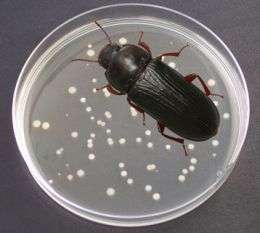Two-phase microbial resistance: the example of insects

(PhysOrg.com) -- In less than an hour, the immune system of the beetle Tenebrio molitor neutralizes most of the bacteria infecting its hemolymph (the equivalent to blood in vertebrates); this is rendered possible by a cascade of ready-to-use cells and enzymes. Bacteria that resist these "front-line" defenses are then dealt with by antimicrobial peptides – a sort of natural antibiotic – which halt their proliferation.
A clearer understanding of these actors in insect immunity may make it possible to design treatments that prevent the development of drug resistance. This has been shown in the results of a study carried out by the Equipe Ecologie Evolutive in the Laboratoire Biogéosciences (CNRS/Université de Bourgogne in Dijon), in collaboration with a British research group, and published in the last issue of Science.
Microorganisms have a considerable capacity for adaptation to the many strategies implemented to destroy them. Over the past 400 million or so years, the immune system of animals, and notably the relatively simpler system in insects, appears to have succeeded in preventing the evolution of microbial resistance. The secret to this achievement lies in a small toolbox of targeted natural antibiotics, the antimicrobial peptides.
In the present case, the researchers showed that the so-called "constitutive" front-line of cellular and enzymatic defenses in the insect immune system spares a small number of bacteria and thereby favors the development of microbial resistance. However, a second line of defenses involving antimicrobial peptides synthesized following the elimination of most bacteria by the front line, is able to restrict the growth of these surviving microorganisms, which may lead to their removal.
Thus the principal function of the antimicrobial peptides produced by the insect immune system is to prevent the resurgence of bacteria resistant to the host's constitutive defenses, which will consequently reduce the emergence of resistant bacteria.
References: Antimicrobial defence and persistent infection in insects, Eleanor R. Haine, Yannick Moret, Michael T. Siva-Jothy and Jens Rolff, to appear in Science, 21 November 2008
Provided by CNRS
















